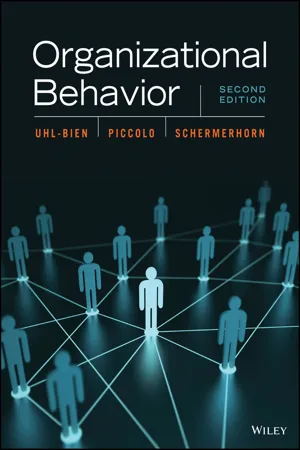Business
Challenges and Opportunities for OB
Challenges and opportunities for organizational behavior (OB) in business encompass the complexities of managing diverse teams, adapting to rapid technological advancements, and fostering a positive organizational culture. These challenges present opportunities for innovation, improved decision-making, and enhanced employee engagement. By addressing these challenges and leveraging the opportunities, businesses can cultivate a more productive and harmonious work environment.
Written by Perlego with AI-assistance
Related key terms
1 of 5
3 Key excerpts on "Challenges and Opportunities for OB"
- eBook - ePub
Organizational Behaviour
Performance Management in Practice
- Richard Pettinger(Author)
- 2013(Publication Date)
- Routledge(Publisher)
Chapter 3 . Organizations have to be capable of responding to changes and pressures in their environment; and they also have to be able to change themselves in order to meet fresh challenges and developments. Organizations have to be capable of accommodating advances in human and technological knowledge, and in harmonizing these to best effect in the pursuit of successful activities.The overall context is bounded by the need for managerial expertise in integrating all of the lessons into a body of understanding that forms the basis for the study of knowing how people think, behave, act and react in a variety of situations.xxivPassage contains an image
1 Introduction
DOI: 10.4324/9780203857595-2Organizational behaviour is concerned with the study of the behaviour and interaction of people in restricted or organized settings. It involves the understanding of, and prediction of, the behaviour of people, and of the means by which their behaviour is influenced and shaped.Organizations are bodies or entities created for a stated purpose. They may consist of one or more people. In the case of the sole trader or single operator, he/she needs to build relationships with suppliers, contractors, customers, clients and the community. For those that consist of more than one person, internal as well as external relationships have to be created and maintained. Organizations therefore consist of individuals, groups and relationships. Objectives, structures, systems and processes are then created to give life, direction and order to activities and interactions.Organizational behaviour is therefore of great concern to anyone who organizes, creates, orders, directs, manages or supervises the activities of others. It is also of concern to those who build relationships between individuals, groups of people, different parts of organizations, and between different organizations themselves because all of these activities are founded on human interaction. - eBook - PDF
- Mary Uhl-Bien, Ronald F. Piccolo, John R. Schermerhorn, Jr.(Authors)
- 2020(Publication Date)
- Wiley(Publisher)
Organizational strategy is the mission, vision, and initiatives an organization takes to achieve long-term business goals. 2.1 Why Context Matters in OB 2-3 vision, and values of an organization. Many people miss the importance of strategy for OB. They focus on their local level and individual motivations and worldview. Doing this sets them up for disappointment when their needs are not met. For example, the strategy of most hospitals is set by top management and focuses on keeping the hospital running efficiently and effectively. Doctors, however, live in the world of patients. They are not trained in business or attuned to strategy. Doctors can get frustrated when they clash with hospital administrators who reject their requests for new equipment or procedures focused on patients, because administrators also have to take into consideration the financial needs and strategic priorities of the overall healthcare system. The bottom line is that in OB, we always need to consider how what we are doing aligns with the organization’s strategy. Strategy determines the way internal resources are allocated, how the company evaluates performance, what kinds of employees are hired, how employees are trained, which behaviors are rewarded, and which are punished. Some tips for managing OB relative to strategy include: • Pay attention to the strategic direction and priorities of the organization. These are usually listed on the company webpage and discussed in organizational communications. • Align your work contributions with strategic priorities and organizational and work unit goals. • Frame messaging and resource requests in the context of the strategy. • Demonstrate initiative and be proactive in helping organizational managers recognize and address strategic threats and opportunities. Rewards: Why People Do What They Do Another important factor to consider is rewards. Rewards help us to understand why people do what they do. - eBook - PDF
- James L. Bowditch, Anthony F. Buono, Marcus M. Stewart(Authors)
- 2015(Publication Date)
- Wiley(Publisher)
Although you may not initially think about it as you read through this book, one of the most difficult issues in OB deals with questions of organizational ethics. Top- ics such as motivation, trust in relationships, the psychological contract, influence and persuasion, goal setting, and behavior modification all have strong ethical content. The application of OB concepts in such managerial practices as management by objectives (MBO), performance reviews, assessment centers, and reward and control systems, as well as issues raised by organization design, leadership, power, and organizational pol- itics are also influenced by ethical concerns. 7 The growing sociodemographic diversity in the workplace continues to raise our awareness about discrimination and employee rights, sexual harassment, and the use of psychological examinations. In fact, a study of the “tough choices” managers face in their daily job experiences found that the most frequently cited sources of ethical concern fell in the realm of managing their firms human resources: (1) performance evaluation and resultant hiring, firing, promotion, 4 Chapter 1 Management and Organizational Behavior and demotion decisions; (2) designing and administering personnel policies and systems (e.g., disability policies, reward systems); and (3) managing relationships on the job. 8 Such studies underscore that ethical dilemmas in business are an intricate part of, not separate from, the routine practices of management. Enron’s Peer Review Committee (PRC) provides a good illustration of such “tough choices” in action. The PRC process—referred to internally as the firm’s practice of “rank and yank”—ranked all employees on a scale of 1 to 5 every six months. The bottom 15 percent was automatically “redeployed”—in essence, they were given a few weeks to find another job within the company or be let go.
Index pages curate the most relevant extracts from our library of academic textbooks. They’ve been created using an in-house natural language model (NLM), each adding context and meaning to key research topics.


